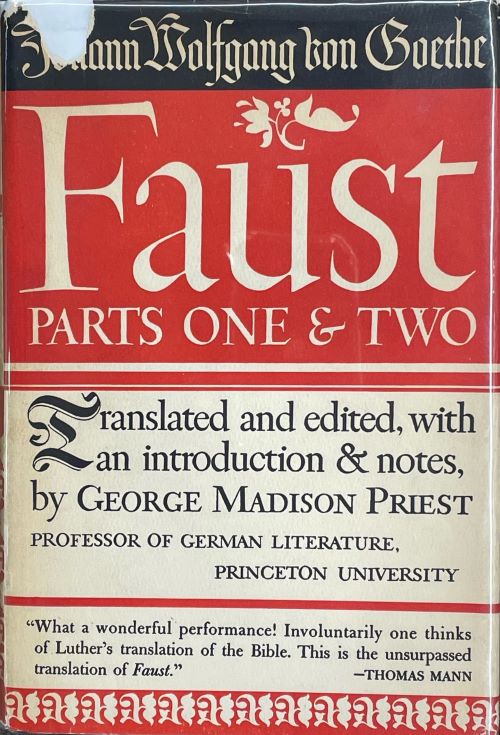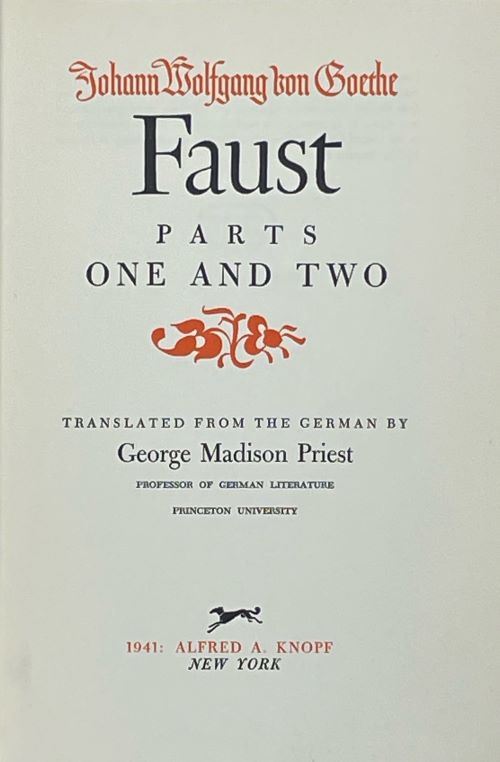This visit to the Liberty Fund rare book room is for the mid-century modern design fans. Pierre Goodrich's 1941 copy of Goethe's Faust, published by Knopf, is a perfect example of the charms of mid century book design, as well as further evidence of Goodrich's fondness for classic works of literature and important moral questions.
The Reading Room
Faust: From the Liberty Fund Rare Book Room
To me, it looks as if the designer of this edition of Faust set out to use as many fonts as he possibly could. I count three distinct fonts on the book's spine--including the beautifully appropriate faux black letter font used for the book's title. (readers who are font junkies may be able to help identify and name the various fonts used. Let me know in the comments!) The cover of the book just keeps going.
A completely different black letter font is used for Goethe's name. The title is redone in a more modern font--though the pointed serifs still hark back to the Germanic black letter fonts. This is followed by a whimsical capital T, reminiscent of an illuminated medieval capital. This is followed, surprisingly, by something resembling nothing so much as Times New Roman for the remainder of the book cover.
It's a glorious cacophony of fonts, tamed by the austere red, white, and black design of the cover, which is echoed (in reverse) by the title page.

Inside, of course, is Goethe's glorious Faust, which returns to and revises the medieval legend of a scholar who makes a deal with the Devil in order to gain knowledge. In Goethe's hands, the relatively simple medieval story's warnings about exceeding the bounds of human reason are transformed into a grand, Romantic exploration of the human soul, the meaning of good and evil and life and death, and the battle between reason and passion. Goodrich was clearly fascinated with the complexities of the text and with the rich history of tellings and retellings of the Faust legend over the centuries. As with so many of his books, when you open his edition of Faust, you find it has been well read and annotated. You can see below some notes in Goodrich's famously undecipherable hand which he has interleaved with Goethe's drama.

A completely different black letter font is used for Goethe's name. The title is redone in a more modern font--though the pointed serifs still hark back to the Germanic black letter fonts. This is followed by a whimsical capital T, reminiscent of an illuminated medieval capital. This is followed, surprisingly, by something resembling nothing so much as Times New Roman for the remainder of the book cover.
It's a glorious cacophony of fonts, tamed by the austere red, white, and black design of the cover, which is echoed (in reverse) by the title page.

Inside, of course, is Goethe's glorious Faust, which returns to and revises the medieval legend of a scholar who makes a deal with the Devil in order to gain knowledge. In Goethe's hands, the relatively simple medieval story's warnings about exceeding the bounds of human reason are transformed into a grand, Romantic exploration of the human soul, the meaning of good and evil and life and death, and the battle between reason and passion. Goodrich was clearly fascinated with the complexities of the text and with the rich history of tellings and retellings of the Faust legend over the centuries. As with so many of his books, when you open his edition of Faust, you find it has been well read and annotated. You can see below some notes in Goodrich's famously undecipherable hand which he has interleaved with Goethe's drama.
